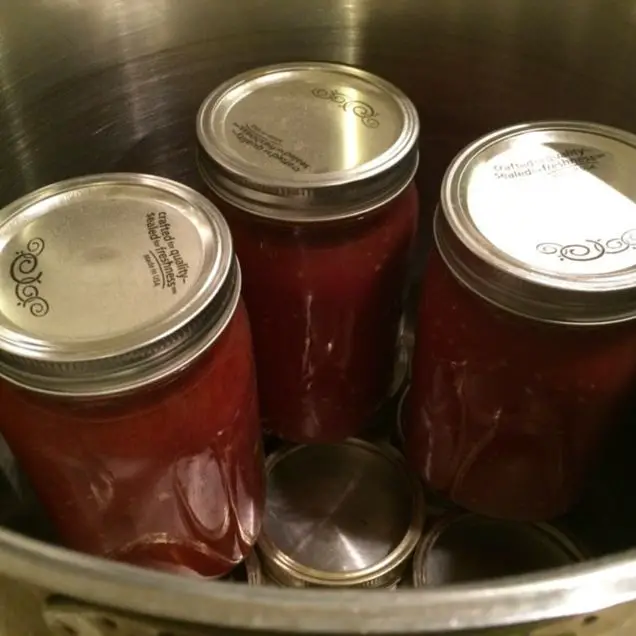FREE: 10 Must-Know Tomato Growing Tips Get The Guide
Read our affiliate disclosure here.
How to Choose a Hot Water Bath Canner for Canning Tomatoes
Since 2010, Tomato Dirt has garnered 4.8+ million views, making it the web’s leading online source for growing tomatoes in the home garden. Award-winning writer and Tomato Dirt owner Kathy Widenhouse has helped thousands of home gardeners grow healthier tomatoes. Be one of them when you get Tomato Dirt’s Growing Guide here.
Updated 8.5.24
A hot water bath canner is a deep, tightly covered metal pot with a rack or basket in the bottom. The canner is deep enough to hold jars, plus an inch or two of water to cover them with a few inches above that for boiling water. Filled jars are placed in the rack and lowered into the canner. Water is brought to a boil over jars to process the tomatoes.
(In addition to a canner, you need a few other supplies and tools to can tomatoes. Many of these items come with canner sets. You can also buy them individually. Read a list of those items and how to use them.)
Tomatoes are a borderline acid food but can be preserved safely in one of these hot water bath canners, especially when you add a bit of lemon juice to them to lower acidity below the 4.6 pH threshold … just in case. (You can process tomatoes safely in pressure canners, regardless of acidity levels.) Acidity prevents Clostridium botulinum bacteria from growing. Plus, the heat kills other bacteria, molds, and spores in the tomatoes. In addition, boiling removes the oxygen remaining in the jar, which helps to form a tight seal between the lid and the rim.
For many, a hot water bath canner doubles as a large kitchen pot. Its size allows you to use it to blanch vegetables or even cook large quantities of soups and stews.
Consider several factors as you choose a hot water bath canner that’s best for your situation.
Size
The most common size canner, a 21-quart pot, is just the right size for holding 7 one quart jars. Smaller bath canners (11.5 quarts) can hold 7 pint jars. A jumbo canner (33 quart capacity) holds 9 quart jars, which is a good choice if you process large amounts of produce.
The canner should be deep enough to allow at least one inch of rolling boiling water to cover jars during processing – whichever size canner you choose to use. (You can process pint jars in a pot large enough for quart jars, too.) To ensure uniform processing, the canner should be no more than 4 inches wider in diameter than the heating element on your stove. In other words, the canner should not extend over the edge of the burner by more than 2 inches on either side.
Material
Porcelain enamel on steel
This traditional canning pot is a black or blue granny ware-type canner. The dark, speckled porcelain surface is the result of powdered glass fused onto steel, creating a durable, smooth, hard finish. The steel absorbs heat and distributes it evenly. Porcelain/steel canners are inexpensive. Even so, they are prone to chipping, which leads to rusting. These canners are also not recommended for smooth glass or ceramic electric stove surfaces.
Stainless steel
A stainless steel water bath canner will not rust. These are a great investment for someone who does a lot of canning each year.
Aluminum
Aluminum doesn’t chip and rust. But keep in mind that a lower gauge aluminum bends easily. Nicks and bumps can affect how the lid fits and how jars sit in the pot.
Bottom surface
Some hot water canners have smooth bottom surfaces; others have ridges. If your stove has electric burners, choose a flat bottom canner to allow even heat distribution. If your stove has gas burners, then either a flat or ridged bottom works.
Lid
Does the lid fit securely? A loose lid means water will take longer to boil. If steam escapes easily, your canner will require more heat to maintain a boil while processing. A tempered glass lid lets you see if water is boiling without the need for lifting and peeking. Some lids even have tiny steam vents or temperature gauges.
Handles
Silicone-coated handles helps canner stay reasonably cool to the touch. Porcelain, aluminum, or stainless steel handles will get hot quickly. Be prepared to use potholders to protect your fingers.
(See a good assortment of hot water bath canners here.)
More on canning tomatoes
Canning tomatoes: the basics you need to know to get started ...
Pressure canner or hot water bath canner? How to decide ...
Canning supplies you need to can tomatoes ...
Canning Tomatoes FAQs: Frequently Asked Questions ...
How to Store Tomatoes: A Gardener’s Guide ...
More tips for canning tomatoes on our Pinterest board ...
Return from How to Choose a Hot Water Bath Canner for Tomatoes to Tomato Dirt home
As an Amazon Associate and Rakuten Advertising affiliate I earn from qualifying purchases.
SHARE THIS PAGE:
FREE! 10 Must-Know Tomato Growing Tips: 20-page guide
Get yours here:





New! Comments
Have your say about what you just read! Leave a comment in the box below.